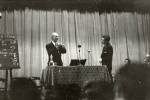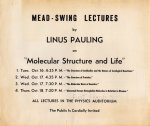|
The final section of the 1949 paper discussed genetics. The Caltech authors stated
that people suffering from sickle cell anemia were homozygous, whereas people with
sickle cell trait were heterozygous. The Longsworth scanning diagrams that they reproduced
with their article, definitively show that those with sickle cell trait hemoglobin
have two distinct peaks – one that resembles the peak of sickle cell anemia hemoglobin
and one that resembles the peak of normal hemoglobin. Thus, they found that sicklemics
had one normal allele producing normal hemoglobin and one sickle cell allele producing
sickled hemoglobin.
In their discussion on genetics, the authors mentioned that geneticist James V. Neel of the Heredity Clinic at University of Michigan had published a paper earlier that
year and proposed the same genetic conclusion. Neel had analyzed the blood of parents
and their children and concluded that sickle cell trait is a heterozygous trait, and
sickle cell anemia is homozygous recessive. Science published Neel's paper in July 1949, four months before the Caltech paper. Pauling
and his collaborators wanted it to be on the record that they reached the same conclusion
independently of Neel.
The men at Caltech provided more information about sickle cell anemia than Neel. Their
chemical analysis of blood using electrophoresis demonstrated the difference between
normal and sickle cell hemoglobin as well as showed sickle cell trait hemoglobin to
be a mixture of normal and sickle cell hemoglobins.
|
|
Click images to enlarge

Linus Pauling lecturing on sickle cell anemia, Kyoto, Japan. 1955.

Mead-Swing Lectures, October 16 - 18, 1956.
"The demonstration that sickle cell hemoglobin differs in electrophoretic mobility
from normal hemoglobin led to the entitled inference: 'Sickle cell anemia, a molecular
disease.' This astonishingly simple concept is of fundamental importance to medicine
for the ultimate understanding of the origins of sickness, and to biology for the
insight into what genes do. In the author's words, 'This investigation...reveals a
clear case of a change produced in a protein molecule by an allelic change in a single
gene involved in synthesis.'"
|

